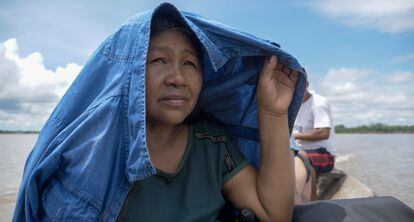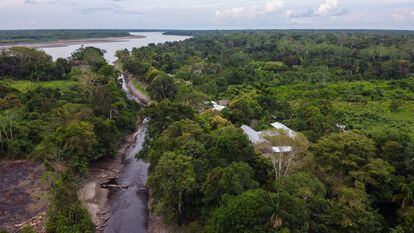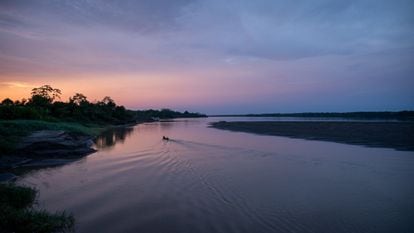EL PAÍS offers the América Futura section openly for its daily and global information contribution on sustainable development. If you want to support our journalism, subscribe here.
A river stained with oil. That is what the Marañón has become after decades of oil spills in the northern Peruvian Amazon. However, for the Kukama Kukamiria—rooted in its shores for more than two centuries—it is much more than that. “The Marañón is a father for us and all living beings,” says Mari Luz Canaquiri Murayari, president of the Huaynakana Kamatahuara Kana Federation, which brings together women from 29 indigenous communities located on its banks. “Before we were very happy with our immense river, but now we only feel pain for what they have done to it,” she laments.
The second longest river in Peru—which stretches for more than 1,700 kilometers to join the Amazon—carries the weight of more than 60 oil spills from the NorPeruano Pipeline between 1997 and 2019, according to Osinergmin. More than half of such disasters are due to the lack of maintenance of this 1,106 kilometer pipeline, operated by the state company Petroperú, which transports crude oil from the jungle to the Peruvian coast.
Mari Luz Canaquiri is 49 years old, but she was barely a child when she first experienced one of those spills in Shapajilla. This community, like the rest in this basin, does not have access to drinking water. “It was as if nothing happened,” recalls the indigenous leader. “We drank water from the same river because no one informed us that oil was harmful, until we got sick and that's how they slowly killed us.”
Overwhelmed by this pollution, in mid-2021, the daughters, mothers and grandmothers who make up the Huaynakana Kamatahuara Kana Federation They sued the Peruvian State to declare Marañón subject to rights. “We want them to respect the river, to stop violating their rights and ours,” explains Canaquiri, recognized with the Terre de Femmes International Award 2023 for his fight. “We want them to respect this sacred river that guards our ancestors, who inhabit a world under its waters,” he adds.

Not only oil has plunged the Marañón into a silent tragedy. A series of infrastructure projects – such as hydroelectric dams and the Amazon Waterway – endanger the life of one of the main water arteries of the Peruvian jungle, according to the International Union for Conservation of Nature. The same goes for illegal gold mining, which contaminates it with mercury and other toxic metals.
In response, the Kukama Kukamiria's constitutional lawsuit—backed by the Legal Defense Institute, International Rivers, and Earth Law Center—seeks to grant specific rights to the Marañón. Among them, the right to exist, to flow, to be free of all contamination, to the restoration and regeneration of its natural cycles.
“These are rights that have been trampled,” says Celia Fasabi, vice president of the indigenous federation and health agent in her Nuevo San Juan community. At 37 years old, she has witnessed the many ways in which the pollution of the Marañón affects the lives of the kukama, especially women: from skin diseases, pregnancies that end in spontaneous abortions, to cancer. “We can only defend the river until the last days of our lives, so that they respect their lives and ours.”
If it happens, it would not be the first time that a body of water is declared a living being and subject of rights in Latin America. In mid-2016, the Constitutional Court of Colombia recognized the Atrato River in Chocó as such, something that had previously only happened with the Ganges in India and the Wanganui in New Zealand.
For Monti Aguirre, from International Rivers, what happened in Colombia lit a light throughout the region. “They were requesting rights for the affected communities, but the judge also granted rights to the river that had suffered from mining,” explains the expert from the international organization that supported the Kukama Kukamiria's demand with a amicus curiae together with Earth Center Law and the Global Alliance for the Rights of Nature. “That showed that we have laws and policies that work, in quotes, for the well-being of human beings, but if the well-being of nature is not protected, then that of human beings is not protected either.”
Peru has not been far from this rights of nature movement, even more so since the advisory opinion of the Inter-American Court of Rights in 2017. This recognizes that nature has an intrinsic value in itself, beyond its usefulness for people and, as such, it must be protected, thus recognizing their rights.
“That set a precedent for us,” says Juan Carlos Ruiz, lawyer at the Legal Defense Institute and in charge of the defense of the kukama kukamiria. “What the Court says is binding on Peru and that has been the legal argument we used to request that the rig
hts of the Marañón be recognized.”

This lawsuit—against Petroperú, the Ministries of the Environment and Energy and Mines, among other public entities—also requests the maintenance and repair of the NorPeruano Pipeline, built in the 1970s. However, in the judicial hearing before the Mixed Court of Nauta last November, the Ministry of the Environment refused to recognize the urgency of adopting protection measures for the Marañón River, as reported by the Legal Defense Institute.
“It was evident that the State does not feel responsible and unfortunately it has been like this for a long time,” explains Monti Aguirre. “What Kumama women demand makes us see beyond the anthropocentric and understand that we depend on the natural world for our own existence.”
Despite the state's denial, crude oil continues to permeate the waters of the Marañón. “Many times it comes out and floats in the river, that is, we have never stopped being contaminated,” says Mari Luz Canaquiri. “It is as if we did not exist, although it is thanks to us that our Amazon is maintained, if not, they would have already exterminated it.”
The lawsuit, in effect, also seeks the recognition of women as guardians of the Marañón and its tributaries. This is a figure that has been achieved in other cases, such as Colombia. For Constanza Prieto Figelist, from Earth Law Center, “this would allow them to have a better form of representation, not only of their communities, but of the interests of the river for its protection.” “If this is the case, we could say that a new stage in environmental law is opening in Peru.”
Consequently, they would be legal representatives of the river and its tributaries in making decisions on legislative, administrative and executive acts, as well as projects that could directly or indirectly affect them. The river and its tributaries could sit at the table and be heard through the voices of its guardians.

But for a long time that voice, that of the kukama, was silenced. As in most indigenous peoples, machismo prevented women from having the say. “We wanted them to listen to us to defend our ancestral territory, but they didn't even let us give our opinion,” recalls Celia Fasabi. “That only made us stronger to organize and now they have understood that this fight is for our river, for our lives.”
In the coming months, the Mixed Court of Nauta, in Loreto, will issue a ruling that could be historic. For Mari Luz Canaquiri, it is crucial to reiterate that this fight is for everyone. “If the judge agrees with us, it will also be a benefit for her, for all Amazonians, for Peru and the world,” she emphasizes. Although the Kukama Kukamiria are people of the river, the long struggle of their women is for the most basic thing, for the right to exist and live.
#indigenous #women #sued #Peruvian #State #protect #river